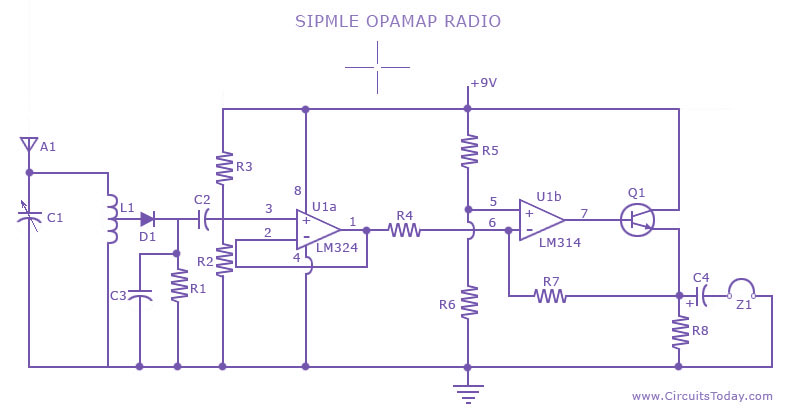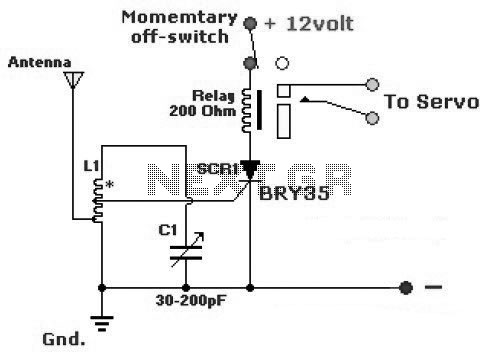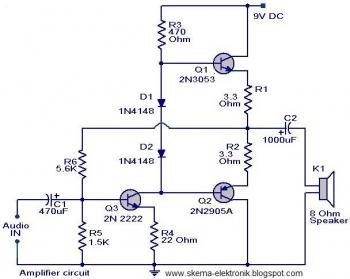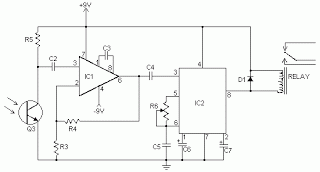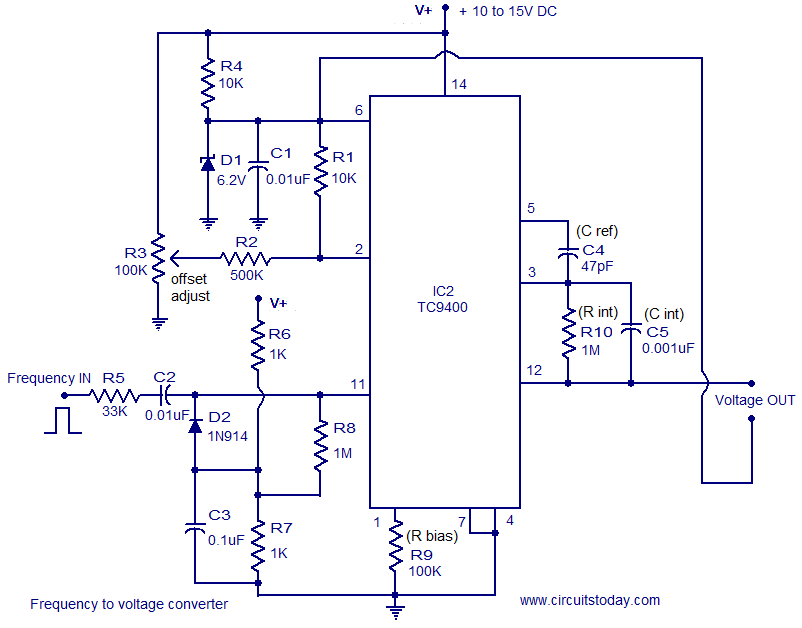
A simple tuned radio frequency receiver
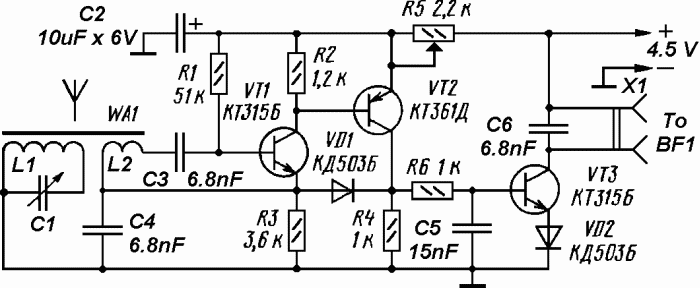
This simple tuned radio frequency receiver was designed and constructed in the mid-1990s. The receiver was tested under urban and field conditions, in varying temperatures. This straightforward circuit exhibits high sensitivity, good sound quality, and reliability. A signal received by a ferrite rod loop antenna is applied to a resonant tank circuit consisting of inductor L1 and capacitor C. The signal then passes through coupling coil L2 to a two-stage transistor amplifier (VT1 and VT2), functioning as a reflex amplifier. The amplified signal from resistor R4 is directed to an envelope detector, which includes diode VD1 and an RC filter made up of resistor R3 and capacitor C4. The diode is biased, with the bias depending on the operating mode of the transistors, which can be adjusted using potentiometer R5. This biasing enables the detector to function effectively for weak signal reception. The audio signal from the detector is fed back into the same amplifier (VT1 and VT2). From the amplifier's output, the audio signal is sent through a low-pass filter composed of resistor R6 and capacitor C5 to an audio amplifier based on transistor VT3. The load for this amplifier is headphones with an impedance of 1600 Ohms, connected to terminals X1. A negative voltage, proportional to the amplitude of the signal, appears at the output of the detector. This negative voltage activates transistors VT1 and VT2, modifying the bias of the detector and reducing its gain. For AM signal reception, negative audio feedback through the detector enhances detection linearity, resulting in high-quality sound. Any suitable loopstick antenna and a variable capacitor from a portable radio receiver may be utilized in this circuit. The components are mounted on a printed circuit board (PCB), which is housed in an appropriate plastic casing. The volume control potentiometer R5 is mounted on the side of the housing and can help mitigate interference in certain situations. The circuit does not require alignment. The power supply voltage is 4.5 V, achieved by connecting three 1.5 V batteries in series, with a current consumption of approximately 10 mA when no signal is present.
The tuned radio frequency receiver operates by utilizing a ferrite rod loop antenna, which is effective for capturing radio signals across various frequencies. The resonant tank circuit, composed of inductor L1 and capacitor C, is critical for selecting the desired frequency while rejecting others. The coupling coil L2 facilitates the transfer of the received signal to the reflex amplifier, which amplifies the signal in two stages using transistors VT1 and VT2. This design enhances the overall gain and sensitivity of the receiver.
The envelope detector plays a vital role in demodulating the received amplitude-modulated (AM) signals. The use of a biased diode VD1 allows the circuit to effectively handle weak signals, while the RC filter smooths the output, providing a clean audio signal. The feedback mechanism through the amplifier ensures that the gain is adjusted dynamically based on the signal strength, thereby maintaining audio quality.
The audio amplifier stage, utilizing transistor VT3, is designed to drive headphones with a specific impedance. The low-pass filter preceding this stage ensures that only the desired audio frequencies are passed, minimizing distortion and enhancing sound clarity.
The design's flexibility allows for the use of various antennas and capacitors, making it adaptable to different applications. The compact nature of the PCB and the housing ensures portability, while the placement of the volume control potentiometer enhances user convenience. Overall, this receiver circuit exemplifies a robust design for effective radio signal reception and audio output.This simple tuned radio frequency receiver (Fig. 1) was designed and constructed in the mid 1990s. The receiver was tested under urban and field conditions, in the heat and cold. This simple circuit has quite high sensitivity, good sound quality and reliability. A signal received by a ferrite rod loop antenna WA1 and applied to a resonant tank L1C 1, passes through the coupling coil L2 to the two-stage transistor amplifier (VT1, VT2). This is the reflex amplifier. The amplified signal from the resistor R4 is fed to the envelope detector that consists of a diode VD1 and a RC filter R3C4. The diode is biased, the bias depends on the operating mode of transistors. The operating mode may be adjusted by the potentiometer R5. Due to the bias, the detector works well for receiving weak signals. The audio signal from the detector goes back to the same amplifier (VT1, VT2). From the output of the amplifier the audio signal passes through the low pass filter R6C5 to an audio amplifier based on the transistor VT3.
The load of this amplifier is headphones TA-56M (1600 Ohms) connected to the terminals X1. A negative voltage, proportional to the amplitude of the signal appears at the output of the detector. This negative voltage opens the transistors VT1, VT2 and changes the bias of the detector, reducing its gain.
When receiving AM signals, a negative audio feedback across the detector improves the linearity of detection. The result is high quality sound. In this circuit may be used any suitable loopstick antenna and a variable capacitor from any portable radio receiver.
The components are mounted on a PCB, the PCB is placed in any suitable plastic housing. The potentiometer R5 (volume control) is mounted on a side of the housing. In some cases the potentiometer can help to reduce the interferences. The circuit doesn`t require alignment. The voltage of the power supply is 4. 5 V, which is formed by serially connecting three batteries of 1. 5 V. The consumption current is about 10 mA (when there is no signal). 🔗 External reference
The tuned radio frequency receiver operates by utilizing a ferrite rod loop antenna, which is effective for capturing radio signals across various frequencies. The resonant tank circuit, composed of inductor L1 and capacitor C, is critical for selecting the desired frequency while rejecting others. The coupling coil L2 facilitates the transfer of the received signal to the reflex amplifier, which amplifies the signal in two stages using transistors VT1 and VT2. This design enhances the overall gain and sensitivity of the receiver.
The envelope detector plays a vital role in demodulating the received amplitude-modulated (AM) signals. The use of a biased diode VD1 allows the circuit to effectively handle weak signals, while the RC filter smooths the output, providing a clean audio signal. The feedback mechanism through the amplifier ensures that the gain is adjusted dynamically based on the signal strength, thereby maintaining audio quality.
The audio amplifier stage, utilizing transistor VT3, is designed to drive headphones with a specific impedance. The low-pass filter preceding this stage ensures that only the desired audio frequencies are passed, minimizing distortion and enhancing sound clarity.
The design's flexibility allows for the use of various antennas and capacitors, making it adaptable to different applications. The compact nature of the PCB and the housing ensures portability, while the placement of the volume control potentiometer enhances user convenience. Overall, this receiver circuit exemplifies a robust design for effective radio signal reception and audio output.This simple tuned radio frequency receiver (Fig. 1) was designed and constructed in the mid 1990s. The receiver was tested under urban and field conditions, in the heat and cold. This simple circuit has quite high sensitivity, good sound quality and reliability. A signal received by a ferrite rod loop antenna WA1 and applied to a resonant tank L1C 1, passes through the coupling coil L2 to the two-stage transistor amplifier (VT1, VT2). This is the reflex amplifier. The amplified signal from the resistor R4 is fed to the envelope detector that consists of a diode VD1 and a RC filter R3C4. The diode is biased, the bias depends on the operating mode of transistors. The operating mode may be adjusted by the potentiometer R5. Due to the bias, the detector works well for receiving weak signals. The audio signal from the detector goes back to the same amplifier (VT1, VT2). From the output of the amplifier the audio signal passes through the low pass filter R6C5 to an audio amplifier based on the transistor VT3.
The load of this amplifier is headphones TA-56M (1600 Ohms) connected to the terminals X1. A negative voltage, proportional to the amplitude of the signal appears at the output of the detector. This negative voltage opens the transistors VT1, VT2 and changes the bias of the detector, reducing its gain.
When receiving AM signals, a negative audio feedback across the detector improves the linearity of detection. The result is high quality sound. In this circuit may be used any suitable loopstick antenna and a variable capacitor from any portable radio receiver.
The components are mounted on a PCB, the PCB is placed in any suitable plastic housing. The potentiometer R5 (volume control) is mounted on a side of the housing. In some cases the potentiometer can help to reduce the interferences. The circuit doesn`t require alignment. The voltage of the power supply is 4. 5 V, which is formed by serially connecting three batteries of 1. 5 V. The consumption current is about 10 mA (when there is no signal). 🔗 External reference
